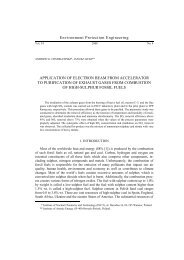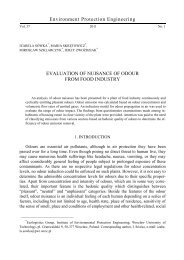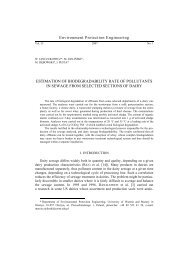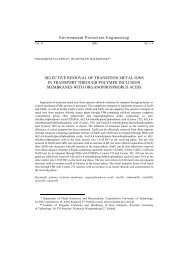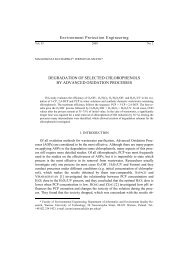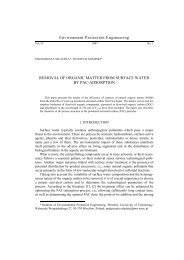Ultrafiltration of-oil-in water emulsion - Environment Protection ...
Ultrafiltration of-oil-in water emulsion - Environment Protection ...
Ultrafiltration of-oil-in water emulsion - Environment Protection ...
You also want an ePaper? Increase the reach of your titles
YUMPU automatically turns print PDFs into web optimized ePapers that Google loves.
<strong>Environment</strong> <strong>Protection</strong> Eng<strong>in</strong>eer<strong>in</strong>g<br />
Vol. 31 2005 No. 3–4<br />
ANDRAS KORIS*, DARKO KRSTIC**, XIANGUO HU***, GYULA VATAI*<br />
ULTRAFILTRATION OF OIL-IN-WATER EMULSION:<br />
FLUX ENHANCEMENT WITH STATIC MIXER<br />
Conventional methods <strong>of</strong> <strong>oil</strong>y <strong>emulsion</strong> separation are not effective <strong>in</strong> remov<strong>in</strong>g small <strong>oil</strong> droplets<br />
and <strong>emulsion</strong>s, especially if the <strong>emulsion</strong> is stable and the <strong>oil</strong> concentration is low. This paper deals with<br />
the <strong>oil</strong> removal from <strong>oil</strong>-<strong>in</strong>-<strong>water</strong> <strong>emulsion</strong> by an ultrafiltration membrane under different operat<strong>in</strong>g<br />
conditions <strong>of</strong> a novel flux enhancement method. Separation <strong>of</strong> <strong>oil</strong>y <strong>water</strong> and waste<strong>water</strong> by membrane<br />
filtration is a well-known process. Generally, because <strong>of</strong> heavy concentration polarization and membrane<br />
foul<strong>in</strong>g, a s<strong>in</strong>gle-stage membrane process is not economical and usually does not provide satisfy<strong>in</strong>g results<br />
<strong>in</strong> retention. In our experiments, 20 nm pore size ceramic tubular membranes were used. In order to<br />
reduce concentration polarization and membrane foul<strong>in</strong>g, the use <strong>of</strong> static turbulence promoters, such as<br />
rods, differently shaped <strong>in</strong>serts and static mixers, has been considered dur<strong>in</strong>g cross-flow ultrafiltration<br />
and micr<strong>of</strong>iltration with different fluids. Helix-like plastic static turbulence promoter was <strong>in</strong>stalled <strong>in</strong> the<br />
experimental apparatus<br />
Keywords: <strong>oil</strong>-<strong>in</strong>-<strong>water</strong> <strong>emulsion</strong>, membrane separation, ultrafiltration, flux enhancement,<br />
concentration-polarization reduction, static mixer<br />
1. INTRODUCTION<br />
Conventional methods <strong>of</strong> <strong>oil</strong>y <strong>emulsion</strong> separation are not effective <strong>in</strong> remov<strong>in</strong>g<br />
small <strong>oil</strong> droplets <strong>of</strong> <strong>emulsion</strong>s, especially if the <strong>emulsion</strong> is stable and the <strong>oil</strong> concentration<br />
is low. Separation <strong>of</strong> <strong>oil</strong>y <strong>water</strong> and waste<strong>water</strong> by membrane filtration is<br />
a well-known process. Generally, because <strong>of</strong> heavy concentration polarization and<br />
membrane foul<strong>in</strong>g, a s<strong>in</strong>gle-stage membrane process is not economical and usually<br />
does not provide satisfy<strong>in</strong>g results <strong>in</strong> retention. There are coupled membrane-filtration<br />
* Corv<strong>in</strong>us University <strong>of</strong> Budapest, Faculty <strong>of</strong> Food Science, Department <strong>of</strong> Food Eng<strong>in</strong>eer<strong>in</strong>g<br />
(www.emuv.kee.hu), 1118, Budapest, Ménesi str 44, Hungary. Tel: (06-1)-372-6232, e-mail: andras.koris@uni-corv<strong>in</strong>us.hu<br />
** University <strong>of</strong> Novi Sad, Faculty <strong>of</strong> Technology, Department <strong>of</strong> Chemical Eng<strong>in</strong>eer<strong>in</strong>g, Bulevar<br />
Cara Lazara 1, 21000 Novi Sad, Serbia and Montenegro.<br />
*** Institute <strong>of</strong> Tribology, Hefei University <strong>of</strong> Technology, Hefei 230009, PR Ch<strong>in</strong>a.
164<br />
A. KORIS et al.<br />
methods mentioned <strong>in</strong> the literature (UF-RO, UF-NF), but <strong>in</strong> these cases both <strong>in</strong>vestment<br />
costs and operat<strong>in</strong>g costs must be high [1], [2]. In some papers, their authors<br />
report that flow relations must be changed above the membrane surface to reduce concentration<br />
polarization and foul<strong>in</strong>g [3], [4]. This can be done by choos<strong>in</strong>g the optimal<br />
flow rate <strong>of</strong> retentate and transmembrane pressure which is <strong>in</strong> agreement with the literature<br />
[5]. To reduce the concentration polarization and membrane foul<strong>in</strong>g the use <strong>of</strong><br />
static turbulence promoters, such as rods, differently shaped <strong>in</strong>serts and static mixers,<br />
has been considered dur<strong>in</strong>g cross-flow ultrafiltration and micr<strong>of</strong>iltration with different<br />
fluids [6]. In this paper, static mixer was applied as turbulence promoter <strong>in</strong> the ultrafiltration<br />
process, so higher permeate fluxes were observed than those obta<strong>in</strong>ed with<br />
non-static mixer produc<strong>in</strong>g great retention even at low transmembrane pressure and<br />
recycled flow rates. Membrane foul<strong>in</strong>g was not serious either. Our research revealed<br />
that no complex membrane process was necessary to separate <strong>oil</strong> from <strong>water</strong>, only a<br />
s<strong>in</strong>gle-step membrane filtration at low recycled flow rate and low pressure can be applied,<br />
thus both <strong>in</strong>vestment costs and operat<strong>in</strong>g costs could be reduced.<br />
2. MATERIALS AND METHODS<br />
Membrane filtration experiments were conducted at different transmembrane pressures<br />
(TMP, 20–200 kPa), and at different retentate flow rates (RFR, 50–200 dm 3 /h).<br />
Dur<strong>in</strong>g the experiments T1-70-20-Z (Pall) ultrafiltration ceramic tube membrane was<br />
applied. The physical properties <strong>of</strong> the membrane are as follows:<br />
• ZrO2 active layer; Al2O3 support;<br />
• <strong>in</strong>ner diameter <strong>of</strong> 6.8 mm; length <strong>of</strong> 250 mm;<br />
• active membrane area <strong>of</strong> 4.62×10 –3 m 2 (mean membrane pore size <strong>of</strong> 20 nm).<br />
Fig. 1. The membrane with its hous<strong>in</strong>g and the static mixer
<strong>Ultrafiltration</strong> <strong>of</strong> <strong>oil</strong>-<strong>in</strong>-<strong>water</strong> <strong>emulsion</strong> 165<br />
To generate a stable <strong>oil</strong>-<strong>in</strong>-<strong>water</strong> <strong>emulsion</strong>, MOL Unisol m<strong>in</strong>eral micro-<strong>emulsion</strong> <strong>oil</strong><br />
was used, feed concentration was 5 w/w%. The <strong>oil</strong> concentrations <strong>in</strong> the permeate and<br />
the feed were determ<strong>in</strong>ed by spectrophotometric method. The membrane apparatus and<br />
method <strong>of</strong> permeate flux measurement are detailed <strong>in</strong> our previous publication [3].<br />
The characteristic parameters <strong>of</strong> the static mixer used dur<strong>in</strong>g the experiments are as<br />
follows:<br />
• Kenics FMX8124-AC, Omega, USA; material: polyacetal;<br />
• 6.35 mm diameter; 152.4 mm length;<br />
• number <strong>of</strong> mix<strong>in</strong>g elements: 24.<br />
The membrane and the static mixer are shown <strong>in</strong> figure 1.<br />
3. RESULTS<br />
When the membrane worked <strong>in</strong> conventional mode (without static mixer) serious<br />
membrane foul<strong>in</strong>g was observed due to the concentration polarization phenomena.<br />
The permeate flux <strong>in</strong>creased m<strong>in</strong>imally with an <strong>in</strong>crease <strong>in</strong> TMP. Operat<strong>in</strong>g at higher<br />
RFR also resulted <strong>in</strong> higher flux (figure 2).<br />
Flux (L/m 2 h)<br />
100<br />
90<br />
80<br />
70<br />
60<br />
50<br />
40<br />
30<br />
20<br />
10<br />
0<br />
0 100 200 300 400 500 600<br />
TMP (kPa)<br />
Fig. 2. Permeate flux versus transmembrane pressure for the membrane work<strong>in</strong>g<br />
<strong>in</strong> conventional mode without static mixer<br />
Figure 3 shows the effect <strong>of</strong> the static mixer on the process efficiency. The flux is<br />
tree times as high as that without the static mixer (150 dm 3 ⋅h –1 ). A large flux improvement<br />
can be expla<strong>in</strong>ed by the turbulence promotion and by a characteristics <strong>of</strong><br />
the flow field created by the static mixer. The enhanced scour<strong>in</strong>g <strong>in</strong> the static mix<strong>in</strong>g<br />
mode operation reduces the thickness <strong>of</strong> the <strong>oil</strong> drop deposit on the membrane surface,<br />
150L/h<br />
200L/h
166<br />
A. KORIS et al.<br />
lead<strong>in</strong>g to a large improvement <strong>of</strong> the permeate flux. Insert<strong>in</strong>g a static mixer turbulence<br />
promoter <strong>in</strong>to a tubular membrane module causes an <strong>in</strong>crease <strong>in</strong> flow rate and<br />
pressure drop at the same flow rate. The hydraulic dissipated power or power required<br />
for circulat<strong>in</strong>g the fluid <strong>in</strong>creases because <strong>of</strong> the <strong>in</strong>crease <strong>in</strong> pressure drop along the<br />
module lead<strong>in</strong>g to large energy consumption. This observation is similar at each crossflow<br />
velocity. Therefore, the improvement <strong>of</strong> performance by us<strong>in</strong>g the static mixer<br />
should be verified tak<strong>in</strong>g account <strong>of</strong> energy consumption.<br />
Flux (L/m 2 h)<br />
250<br />
200<br />
150<br />
100<br />
50<br />
0<br />
0 50 100 150 200 250 300 350 400 450 500<br />
TMP (kPa)<br />
Fig. 3. Permeate flux versus transmembrane pressure for the membrane work<strong>in</strong>g<br />
with static mixer<br />
150L/h<br />
200L/h<br />
Oil retention by the membrane determ<strong>in</strong>ed by spectrophotometric method is shown<br />
<strong>in</strong> the table (without and with static mixer) for the experiments at 150 dm 3 /h and 200<br />
dm 3 /h.<br />
TMP Retention %<br />
RFR = 150 dm 3 /h<br />
Oil retention<br />
Without static mixer With static mixer<br />
Retention %<br />
RFR = 200 dm 3 /h<br />
Retention %<br />
RFR = 150<br />
dm 3 /h<br />
Table<br />
Retention %<br />
RFR = 200<br />
dm 3 /h<br />
200 kPa 99.0 99.9 99.2 99.8<br />
500 kPa 95.2 96 99.9 99.8<br />
It can be seen that at TMP = 200 kPa the concentration <strong>of</strong> the <strong>oil</strong> <strong>in</strong> the samples is<br />
low contrary to the concentration <strong>of</strong> the <strong>oil</strong> at 500 kPa without static mix<strong>in</strong>g <strong>of</strong> emul-
<strong>Ultrafiltration</strong> <strong>of</strong> <strong>oil</strong>-<strong>in</strong>-<strong>water</strong> <strong>emulsion</strong> 167<br />
sion. The filtration gives satisfy<strong>in</strong>g results at 200 kPa <strong>in</strong>dependently <strong>of</strong> us<strong>in</strong>g the static<br />
mixer. When the mixer was <strong>in</strong>stalled retention at higher TMP improved. However this<br />
method shall be energy efficient only at low TMP and RFR.<br />
4. CONCLUSIONS<br />
By us<strong>in</strong>g static mixer, essential flux improvement can be obta<strong>in</strong>ed with efficient<br />
separation. Consider<strong>in</strong>g the resistance-<strong>in</strong>-series model, permeate flux can be enhanced<br />
besides an <strong>in</strong>crease <strong>in</strong> the pressure and CFV by the reduction <strong>of</strong> the resistance <strong>of</strong> filtration.<br />
The resistance <strong>of</strong> the boundary layer and the gel layer decreased by chang<strong>in</strong>g the<br />
flow relations above the membrane surface and caused rise <strong>in</strong> the permeate flux. The<br />
statement that the <strong>in</strong>stallation <strong>of</strong> static turbulence promoters advantageously affects<br />
the process is not possible before exam<strong>in</strong><strong>in</strong>g the cost effect. The phenomena <strong>of</strong> energy<br />
consumption and retention improvement should be considered and discussed. Separation<br />
<strong>of</strong> stable, low concentration <strong>oil</strong>-<strong>in</strong>-<strong>water</strong> <strong>emulsion</strong>s <strong>in</strong> a s<strong>in</strong>gle step cross-flow<br />
ultrafiltration process is possible which means reduced costs compared to complex<br />
treatment methods.<br />
ACKNOWLEDGEMENTS<br />
The authors are grateful for the support from the Hungarian Scientific Foundation (OTKA) (Grant No.<br />
T037848), the S<strong>in</strong>o-Hungarian Intergovernmental S & T Cooperation Programme (Grant No. CHN33:17)<br />
and the M<strong>in</strong>istry <strong>of</strong> Science and <strong>Environment</strong> <strong>Protection</strong>, Republic <strong>of</strong> Serbia (project No. 1362).<br />
REFERENCES<br />
[1] KARAKULSKI K., MORAWSKI A.W., Treatment <strong>of</strong> spent <strong>emulsion</strong> from a cable factory by an <strong>in</strong>tegrated<br />
UF/NF membrane system, Desal<strong>in</strong>ation, 2002, 149, 163–167.<br />
[2] LIN S.H., LAN W.J., Waste <strong>oil</strong>–<strong>water</strong> <strong>emulsion</strong> treatment by membrane processes, Journal <strong>of</strong> Hazardous<br />
Materials, 1998, 59, 189–199.<br />
[3] KORIS A., HU X., VATAI G., <strong>Ultrafiltration</strong> and nan<strong>of</strong>iltration <strong>of</strong> <strong>oil</strong>-<strong>in</strong>-<strong>water</strong> <strong>emulsion</strong>s: comparison<br />
<strong>of</strong> resistances, Scientific reunion <strong>of</strong> the special program <strong>of</strong> the Alexander von Humboldt Foundation<br />
concern<strong>in</strong>g the reconstruction <strong>of</strong> the South Eastern Europe: Susta<strong>in</strong>ability for Humanity and <strong>Environment</strong><br />
<strong>in</strong> the Extended Connection Field Science – Economy – Policy, Timisoara, Romania, proceed<strong>in</strong>gs<br />
I, 2005, pp. 141–144.<br />
[4] HU X., BEKASSY-MOLNAR E., KORIS A., Study <strong>of</strong> modell<strong>in</strong>g the transmembrane pressure and gel<br />
resistance <strong>in</strong> ultrafiltration <strong>of</strong> <strong>oil</strong>y <strong>emulsion</strong>, Desal<strong>in</strong>ation, 2003, 163, pp. 355–360 (PERMEA 2003,<br />
Slovakia, 7–11 September).<br />
[5] MULDER M., Basic Pr<strong>in</strong>ciples <strong>of</strong> Membrane Technology, Kluwer Academic Publishers, 1997.<br />
[6] KRSTIĆ D.M., TEKIĆ M.N., CARIĆ M.Đ., MILANOVIĆ S.D., Static turbulence promoter <strong>in</strong> cross-flow<br />
micr<strong>of</strong>iltration <strong>of</strong> skim milk, Desal<strong>in</strong>ation, 2004, 163, 297–309.



